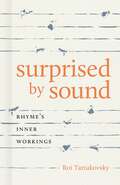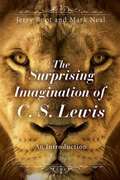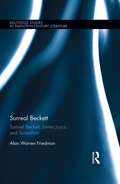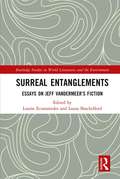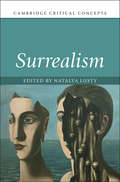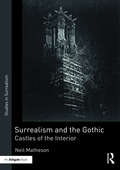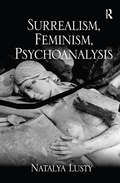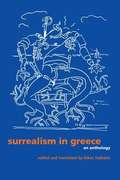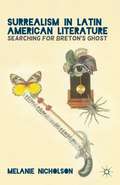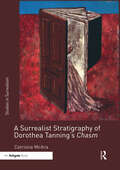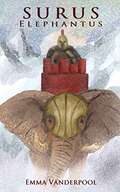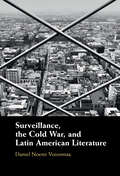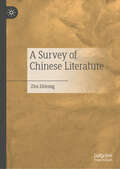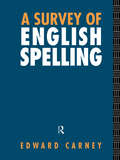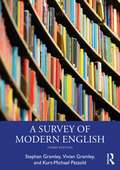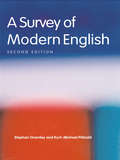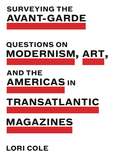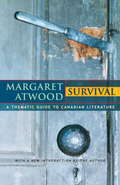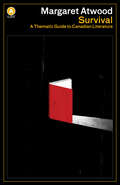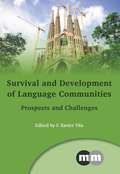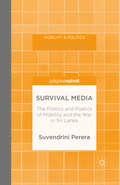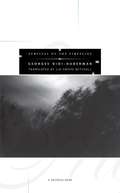- Table View
- List View
Surprised by Sin: The Reader in Paradise Lost
by Stanley FishFirst published in the late 1960s, in an era that no longer saw the need to choose between Milton's orthodoxy and heresy. With a new preface, the author revisits his thesis and considers the challenges offered by post-structuralism, late-20th-century historicism, and political criticism.
Surprised by Sound: Rhyme’s Inner Workings
by Roi TartakovskyIn Surprised by Sound, Roi Tartakovsky shows that the power of rhyme endures well into the twenty-first century even though its exemplary usages may differ from traditional or expected forms. His work uncovers the mechanics of rhyme, revealing how and why it remains a vital part of poetry with connections to large questions about poetic freedom, cognitive and psychoanalytic theories, and the accidental aspects of language.As a contribution to studies of sound in poetry, Surprised by Sound takes on two central questions: First, what is it about the structure of rhyme that makes it such a potent and ongoing source of poetic production and extrapoetic fascination? Second, how has rhyme changed and survived in the era of free verse, whose prototypical poetry is as hostile to poetic meter as it is to the artificial sound of rhyme, including the sound of rhythmic thumping at the end of every line? In response, Tartakovsky theorizes a new category of rhyme that he terms “sporadic.” Since it is not systematized or expected, sporadic rhyme can be a single, strongly resounding rhyme used suddenly in a free verse poem. It can also be an internal rhyme in a villanelle or a few scattered rhymes unevenly distributed throughout a longer poem that nevertheless create a meaningful cluster of words. Examining usages across varied poetic traditions, Tartakovsky locates sporadic rhyme in sources ranging from a sixteenth-century sonnet to a nonsensical, practically unperformable piece by Gertrude Stein and a 2007 MoveOn.org ad in the New York Times. With careful attention to the soundscapes of poems, Surprised by Sound demonstrates that rhyme’s enduring value lies in its paradoxical and unstable nature as well as its capacity for creating poetic, cognitive, and psychic effects.
The Surprising Imagination of C. S. Lewis: An Introduction
by Root Mark Neal Jerry RootNarnia, Perelandra--places of wonder and longing. The White Witch, Screwtape--personifications of evil. Aslan--a portrait of the divine. Like Turkish Delight, some of C.S. Lewis's writing surprises and whets our appetite for more. But some of his works bite and nip at our heels. What enabled C.S. Lewis to create such vivid characters and compelling plots? Perhaps it was simply that C.S. Lewis had an unsurpassed imagination. Or perhaps he had a knack for finding the right metaphor or analogy that awakened readers' imaginations in new ways. But whatever his gifts, no one can deny that C.S. Lewis had a remarkable career, producing many books in eighteen different literary genres, including: apologetics, autobiography, educational philosophy, fairy stories, science fiction, and literary criticism. And while he had and still has critics, Lewis' works continue to find devoted readers. The purpose of this book is to introduce C.S. Lewis through the prism of imagination. For Lewis, imagination is both a means and an end. And because he used his own imagination well and often, he is a practiced guide for those of us who desire to reach beyond our grasp. Each chapter highlights Lewis's major works and then shows how Lewis uses imagination to captivate readers. While many have read books by C.S. Lewis, not many readers understand his power to give new slants on the things we think we know. More than a genius, Lewis disciplined his imagination, harnessing its creativity in service of helping others believe more deeply. "Truly fresh, rhetorically astute works about C. S. Lewis are rare, but this provocative new volume by Jerry Root and Mark Neal emerges at just the right time to reinvigorate Lewis scholarship beyond the clichés we continue to repeat to each other. The Surprising Imagination of C. S. Lewis delivers just that salvo, an ingenious, empathetic, lavishly informed elucidation of Lewis's understanding of the life of the imagination." --Bruce L. Edwards, Professor Emeritus of English and Africana Studies, Bowling Green State University, Bowling Green, OH "Our grasp of 'imagination' is such a pale and paltry thing; Neal and Root offer a much-needed corrective by illustrating Lewis's robust use of the word. The happy result is a more accurate and nuanced reading of Lewis. But there is more: through their careful work, we are graced with a rich, new vocabulary to discern and describe the many uses of creative imagination all around us." --Diana Pavlac Glyer, Professor of English at Azusa Pacific University, Azusa, CA, author of The Company They Keep: C .S. Lewis and J. R. R. Tolkien as Writers in Community "This fabulous book on Lewis's imagination will delight readers new to Lewis and those who, like the authors, have been reading him for decades. It shimmers with the joy of exploration and discovery. The Surprising Imagination of C. S. Lewis is a reliable and inspiring guide not only to Lewis but to a treasure trove of imaginative books that fired Lewis's own imagination. In Robert Frost's delightful phrase, this book is the occasion for a 'fresh think.'" --Wayne Martindale, Emeritus Professor of English, Wheaton College, Wheaton, IL "Jerry Root and Mark Neal make excellent use of Lewis's literary criticism of other authors to show how he employed different varieties of imagination in his own works. The result is a good book about Lewis and an even better one on the capacity of imagination to enrich each of our lives every day." --Mark Noll, Francis A. McAnaney Professor of History, University of Notre Dame, Notre Dame, IN "For nearly four decades I have been reading books and articles in the field of Lewis studies. This volume is one of the most original and fascinating books on Lewis to appear in a long time." --Lyle W. Dorsett, Billy Graham Professor of Evangelism, Beeson Divinity School, Samford University, Birmingham, AL
Surreal Beckett: Samuel Beckett, James Joyce, and Surrealism (Routledge Studies in Twentieth-Century Literature)
by Alan Warren FriedmanSurreal Beckett situates Beckett‘s writings within the context of James Joyce and Surrealism, distinguishing ways in which Beckett forged his own unique path, sometimes in accord with, sometimes at odds with, these two powerful predecessors. Beckett was so deeply enmeshed in Joyce’s circle during his early Paris days (1928 - late 1930s) that James Knowlson dubbed them his "Joyce years." But Surrealism and Surrealists rivaled Joyce for Beckett’s early and continuing attention, if not affection, so that Raymond Federman called 1929-45 Beckett’s "surrealist period." Considering both claims, this volume delves deeper into each argument by obscuring the boundaries between theses differentiating studies. These received wisdoms largely maintain that Beckett’s Joycean connection and influence developed a negative impact in his early works, and that Beckett only found his voice when he broke the connection after Joyce’s death. Beckett came to accept his own inner darkness as his subject matter, writing in French and using a first-person narrative voice in his fiction and competing personal voices in his plays. Critics have mainly viewed Beckett’s Surrealist connections as roughly co-terminus with Joycean ones, and ultimately of little enduring consequence. Surreal Beckett argues that both early influences went much deeper for Beckett as he made his own unique way forward, transforming them, particularly Surrealist ones, into resources that he drew upon his entire career. Ultimately, Beckett endowed his characters with resources sufficient to transcend limitations their surreal circumstances imposed upon them.
Surreal Entanglements: Essays on Jeff VanderMeer’s Fiction (Routledge Studies in World Literatures and the Environment)
by Louise EconomidesThis edited collection approaches the most pressing discourses of the Anthropocene and posthumanist culture through the surreal, yet instructive lens of Jeff VanderMeer’s fiction. In contrast to universalist and essentializing ways of responding to new material realities, VanderMeer’s work invites us to re-imagine human subjectivity and other collectivities in the light of historically unique entanglements we face today: the ecological, technological, aesthetic, epistemological, and political challenges of life in the Anthropocene era. Situating these messy, multi-scalar, material complexities of life in close relation to their ecological, material, and colonialist histories, his fiction renders them at once troublingly familiar and strangely generative of other potentialities and insight. The collection measures VanderMeer’s work as a new kind of speculative surrealism, his texts capturing the strangeness of navigating a world in which "nature" has become radically uncanny due to global climate change and powerful bio-technologies. The first collection to survey academic engagements with VanderMeer, this book brings together scholars in the fields of environmental literature, science fiction, genre studies, American literary history, philosophy of technology, and digital cultures to reflect on the environmentally, culturally, aesthetically, and politically central questions his fiction poses to predominant understandings of the Anthropocene.
Surrealism (Cambridge Critical Concepts)
by Natalya LustyThis book examines the salient ideas and practices that have shaped Surrealism as a protean intellectual and cultural concept that fundamentally shifted our understanding of the nexus between art, culture, and politics. By bringing a diverse set of artistic forms and practices such as literature, manifestos, collage, photography, film, fashion, display, and collecting into conversation with newly emerging intellectual traditions (ethnography, modern science, anthropology, and psychoanalysis), the essays in this volume reveal Surrealism's enduring influence on contemporary thought and culture alongside its anti-colonial political position and international reach. Surrealism's fascination with novel forms of cultural production and experimental methods contributed to its conceptual malleability and temporal durability, making it one of the most significant avant-garde movements of the twentieth century. The book traces how Surrealism's urgent political and aesthetic provocations have bequeathed an important legacy for recent scholarly interest in thing theory, critical vitalism, new materialism, ontology, and animal/human studies.
Surrealism and the Gothic: Castles of the Interior (Studies in Surrealism)
by Neil MathesonSurrealism and the Gothic is the first book-length analysis of the role played by the gothic in both the initial emergence of surrealism and at key moments in its subsequent development as an art and literary movement. The book argues the strong and sustained influence, not only of the classic gothic novel itself – Ann Radcliffe, Charles Maturin, Matthew Lewis, etc. – but also the determinative impact of closely related phenomena, as with the influence of mediumism, alchemy and magic. The book also traces the later development of the gothic novel, as with Bram Stoker’s Dracula, and its mutation into such works of popular fiction as the Fantômas series of Marcel Allain and Pierre Souvestre, enthusiastically taken up by writers such as Apollinaire and subsequently feeding into the development of surrealism. More broadly, the book considers a range of motifs strongly associated with gothic writing, as with insanity, incarceration and the ‘accursed outsider’, explored in relation to the personal experience and electroshock treatment of Antonin Artaud. A recurring motif of the analysis is that of the gothic castle, developed in the writings of André Breton, Artaud, Sade, Julien Gracq and other writers, as well as in the work of visual artists such as Magritte.
Surrealism, Feminism, Psychoanalysis
by Natalya LustyHow did women Surrealists such as Leonora Carrington and Claude Cahun take up the question of female identity in terms of their own aesthetic and intellectual practice? What was the response of women analysts such as Joan Riviere to Freud's psychoanalytic construction of femininity? These are among the questions that Natalya Lusty brings to her sophisticated and theoretically informed investigation into the appropriation of 'the feminine' by the Surrealist movement. Combining biographical and textual methods of analysis with historically specific discussions of related cultural sites such as women's magazines, fashion, debutante culture, sexology, modernist lesbian subculture, pornography, and female criminality, the book examines the ambiguities and blind spots that haunt the work of more central figures such as André Breton, Georges Bataille, Jacques Lacan, Walter Benjamin, and the Surrealist photographer Hans Bellmer. Lusty's examination of a series of psychoanalytic Surrealist themes, including narcissism, fantasy, masquerade, perversion, and 'the double', illuminates a modernist preoccupation with the crisis of subjectivity and representation and its ongoing relevance to more recent work by Cindy Sherman and Judith Butler. Her book is an important contribution to modernist studies that will appeal to scholars and students working across a diverse range of fields, including literary studies, gender studies, visual culture, cultural studies, and cultural history.
Surrealism in Greece
by Nikos StabakisIn the decades between the two World Wars, Greek writers and artists adopted surrealism both as an avant-garde means of overturning the stifling traditions of their classical heritage and also as a way of responding to the extremely unstable political situation in their country. Despite producing much first-rate work throughout the rest of the twentieth century, Greek surrealists have not been widely read outside of Greece. This volume seeks to remedy that omission by offering authoritative translations of the major works of the most important Greek surrealist writers. Nikos Stabakis groups the Greek surrealists into three generations: the founders (such as Andreas Embirikos, Nikos Engonopoulos, and Nicolas Calas), the second generation, and the Pali Group, which formed around the magazine Pali. For each generation, he provides a very helpful introduction to the themes and concerns that animate their work, as well as concise biographies of each writer. Stabakis anthologizes translations of all the key surrealist works of each generation--poetry, prose, letters, and other document--as well as a selection of rarer texts. His introduction to the volume places Greek surrealism within the context of the international movement, showing how Greek writers and artists used surrealism to express their own cultural and political realities. In the decades between the two World Wars, Greek writers and artists adopted surrealism both as an avant-garde means of overturning the stifling traditions of their classical heritage and also as a way of responding to the extremely unstable political situation in their country. Despite producing much first-rate work throughout the rest of the twentieth century, Greek surrealists have not been widely read outside of Greece. This volume seeks to remedy that omission by offering authoritative translations of the major works of the most important Greek surrealist writers. Nikos Stabakis groups the Greek surrealists into three generations: the founders (such as Andreas Embirikos, Nikos Engonopoulos, and Nicolas Calas), the second generation, and the Pali Group, which formed around the magazine Pali. For each generation, he provides a very helpful introduction to the themes and concerns that animate their work, as well as concise biographies of each writer. Stabakis anthologizes translations of all the key surrealist works of each generation - poetry, prose, letters, and other documents - as well as a selection of rarer texts. His introduction to the volume places Greek surrealism within the context of the international movement, showing how Greek writers and artists used surrealism to express their own cultural and political realities.
Surrealism in Latin American Literature
by Melanie NicholsonCharting surrealism in Latin American literature from its initial appearance in Argentina in 1928 to the surrealist-inspired work of several writers in the 1970s, Melanie Nicholson argues that surrealism has exercised a significant and positive influence over twentieth-century Latin American literature, particularly poetry.
A Surrealist Stratigraphy of Dorothea Tanning’s Chasm (Studies in Surrealism)
by Catriona McAraIn A Surrealist Stratigraphy of Dorothea Tanning’s Chasm, Catriona McAra offers the first critical study of the literary work of the celebrated American painter and sculptor Dorothea Tanning (1910–2012). McAra fills a major gap in the scholarship, repositioning Tanning’s writing at the centre of her entire creative oeuvre and focusing on a little-known short story "Abyss," a gothic-flavoured, desert adventure which Tanning worked on intermittently throughout her creative life, finally publishing it in 2004 as Chasm: A Weekend.McAra performs a major reassessment of the visual and literary principles upon which the surrealist movement was initially founded. Combining a groundbreaking methodological approach with reference to cultural theory and feminist aesthetics as well as Tanning’s unpublished journals and notes, McAra reveals Tanning as a key player in contemporary art practice as well as in the historical surrealist milieu.
Surus: Fābula Bellī et Elephanti
by Emma VanderpoolSurus the Elephant is the mightest and largest elephant in the army and as such is Hannibal's favorite. The Carthaginian general has plans that will take his army, including men and elephants alike, from Africa, through Spain and Gaul, and directly into Roman territory. This novella recounts the stories of Surus the Elephant and his Mahout (elephant trainer) Mago as they recount their dangerous journey together to Italy. This book contains some 3,000 words total. Of which, there are 130 different words (excluding proper nouns). The book, with sheltered vocabulary and unsheltered grammar, is geared towards intermediate students.
Surveillance, the Cold War, and Latin American Literature
by Daniel Noemi VoionmaaSurveillance, the Cold War, and Latin American Literature examines secret police reports on Gabriel García Márquez, Pablo Neruda, Octavio Paz, Elena Poniatowska, José Revueltas, Otto René Castillo, Carlos Cerda, and other writers, from archives in Mexico, Chile, Guatemala, Uruguay, the German Democratic Republic, and the USA. Combining literary and cultural analysis, history, philosophy, and history of art, it establishes a critical dialogue between the spies' surveillance and the writers' novels, short stories, and poems, and presents a new take on Latin American modernity, tracing the trajectory of a modern gaze from the Italian Renaissance to the Cold War. It traces the origins of today's surveillance society with sense of urgency and consequence that should appeal to academic and non-academic readers alike throughout the Americas, Europe and beyond.
A Survey of Chinese Literature
by Zhu ZhirongThis book presents a systematic elaboration on Chinese literature and its criticism, with special reference to introducing the predominant role of idea-image. The author holds that image takes on a central position in Chinese literature. Chinese literature is composed of idea-images that depict the scenery and express the emotions in perfect harmony, conveyed through literary language, reflecting the unique aesthetic sensibilities and the creative consciousness of Chinese people. It is created by Chinese literati with an emotion-centered soul, who experience nature and society with a mode of comprehension rooted in sensibility, yet not confined to it. Drawing from the traditional Chinese culture and incorporating the creative expression of Chinese literati, the author expounds systematically on Chinese literature’s basic features and living spirit which are centered on the idea-image. Furthermore, the author discusses the transitional patterns observed in both highbrow and vernacular Chinese literature. Embracing a modern research perspective, the author not only provides insights into traditional literature but also sheds light on its contemporary relevance. This endeavor unveils the unique values inherent in Chinese literature at a profound level, thereby offering invaluable insights into the essence and spirit of Chinese literary tradition.
A Survey of English Spelling
by Edward CarneyPublished at a time when literacy and spelling are issues of topical concern, A Survey of English Spelling offers an authoritative, comprehensive, and up-to-date overview of this important but hitherto neglected area of the English language. The text brings together a vast body of knowledge, both synthesised from diverse sources and original, unpublished research. The emphasis is on a functional exploration of the spelling regularities and markers that underpin literacy in English. An extensive database has been used throughout to provide a wealth of examples, statistics and analyses. The carefully signposted text and detailed contents listing allow students, professionals, teachers and academics in all areas of English Language, Linguistics and Speech Pathology to access specific information with ease.
A Survey of Modern English
by Stephan Gramley Vivian Gramley Kurt-Michael PätzoldA Survey of Modern English covers a wide selection of aspects of the modern English language. Fully revised and updated, the major focus of the third edition lies in Standard American and British English individually and in comparison with each other. Over and beyond that this volume treats other Englishes around the world, especially those of the southern hemisphere countries of Australia, New Zealand, and South Africa as well as numerous varieties spoken in southern, eastern and western Africa and south and southeast Asia and the Pacific. The main areas of investigation and interest include: pronunciation, grammar and vocabulary; multiple facets of English dialects and sociolects with an emphasis on gender and ethnicity; questions of pragmatics as well as a longer look at English-related pidgin and creole varieties This authoritative guide is a comprehensive, scholarly and systematic review of modern English. In one volume the book presents a description of both the linguistic structure of present-day English and its geographical, social, gender, and ethnic variations. This is complemented with an updated general bibliography and with exercises at the end of each chapter and their suggested solutions at the end of the volume, all intended to provide students and other interested readers with helpful resources.
A Survey of Modern English
by Stephan Gramley Michael PátzoldFully revised and updated, the second edition of this authoritative guide is a comprehensive, scholarly and systematic review of modern English. In one volume the book presents a description of both the linguistic structure of present-day English and its geographical, social, gender, and ethnic variations.Covering new developments such as the impact of email on language and corpus-based grammars, this accessible text has been extensively rewritten and brings the survey of modern English right up to date. It also offers new examples and suggestions for further reading.
Surveying the Avant-Garde: Questions on Modernism, Art, and the Americas in Transatlantic Magazines (Refiguring Modernism #26)
by Lori ColeSurveying the Avant-Garde examines the art and literature of the Americas in the early twentieth century through the lens of the questionnaire, a genre as central as the manifesto to the history of the avant-garde.Questions such as “How do you imagine Latin America?” and “What should American art be?” issued by avant-garde magazines like Imán, a Latin American periodical based in Paris, and Cuba’s Revista de Avance demonstrate how editors, writers, and readers all grappled with the concept of “America,” particularly in relationship to Europe, and how the questionnaire became a structuring device for reflecting on their national and aesthetic identities in print. Through an analysis of these questionnaires and their responses, Lori Cole reveals how ideas like “American art,” as well as “modernism” and “avant-garde,” were debated at the very moment of their development and consolidation. Unlike a manifesto, whose signatories align with a single polemical text, the questionnaire produces a patchwork of responses, providing a composite and sometimes fractured portrait of a community. Such responses yield a self-reflexive history of the era as told by its protagonists, which include figures such as Gertrude Stein, Alfred Stieglitz, Jean Toomer, F. T. Marinetti, Diego Rivera, and Jorge Luis Borges.The book traces a genealogy of the genre from the Renaissance paragone, or “comparison of the arts,” through the rise of enquêtes in the late nineteenth century, up to the contemporary questionnaire, which proliferates in art magazines today. By analyzing a selection of surveys issued across the Atlantic, Cole indicates how they helped shape artists’ and writers’ understanding of themselves and their place in the world.Derived from extensive archival research, this book reorients our understanding of modernism as both hemispheric and transatlantic by narrating how the artists and writers of the period engaged in aesthetic debates that informed and propelled print communities in Europe, the United States, and Latin America. Scholars of modernism and the avant-garde will welcome Cole’s original and compellingly crafted work.
Surveying the Avant-Garde: Questions on Modernism, Art, and the Americas in Transatlantic Magazines (Refiguring Modernism)
by Lori ColeSurveying the Avant-Garde examines the art and literature of the Americas in the early twentieth century through the lens of the questionnaire, a genre as central as the manifesto to the history of the avant-garde.Questions such as “How do you imagine Latin America?” and “What should American art be?” issued by avant-garde magazines like Imán, a Latin American periodical based in Paris, and Cuba’s Revista de Avance demonstrate how editors, writers, and readers all grappled with the concept of “America,” particularly in relationship to Europe, and how the questionnaire became a structuring device for reflecting on their national and aesthetic identities in print. Through an analysis of these questionnaires and their responses, Lori Cole reveals how ideas like “American art,” as well as “modernism” and “avant-garde,” were debated at the very moment of their development and consolidation. Unlike a manifesto, whose signatories align with a single polemical text, the questionnaire produces a patchwork of responses, providing a composite and sometimes fractured portrait of a community. Such responses yield a self-reflexive history of the era as told by its protagonists, which include figures such as Gertrude Stein, Alfred Stieglitz, Jean Toomer, F. T. Marinetti, Diego Rivera, and Jorge Luis Borges.The book traces a genealogy of the genre from the Renaissance paragone, or “comparison of the arts,” through the rise of enquêtes in the late nineteenth century, up to the contemporary questionnaire, which proliferates in art magazines today. By analyzing a selection of surveys issued across the Atlantic, Cole indicates how they helped shape artists’ and writers’ understanding of themselves and their place in the world.Based on extensive archival research, this book reorients our understanding of modernism as both hemispheric and transatlantic by narrating how the artists and writers of the period engaged in aesthetic debates that informed and propelled print communities in Europe, the United States, and Latin America. Scholars of modernism and the avant-garde will welcome Cole’s original and compellingly crafted work.
Survival
by Margaret AtwoodWhen first published in 1972, Survival was considered the most startling book ever written about Canadian literature. Since then, it has continued to be read and taught, and it continues to shape the way Canadians look at themselves. Distinguished, provocative, and written in effervescent, compulsively readable prose, Survival is simultaneously a book of criticism, a manifesto, and a collection of personal and subversive remarks. Margaret Atwood begins by asking: "What have been the central preoccupations of our poetry and fiction?" Her answer is "survival and victims."Atwood applies this thesis in twelve brilliant, witty, and impassioned chapters; from Moodie to MacLennan to Blais, from Pratt to Purdy to Gibson, she lights up familiar books in wholly new perspectives.From the Trade Paperback edition.
Survival: A Thematic Guide to Canadian Literature (A List)
by Margaret AtwoodWhen first published in 1972, Survival was considered the most startling book ever written about Canadian literature. Since then, it has continued to be read and taught, and it continues to shape the way Canadians look at themselves. Distinguished, provocative, and written in effervescent, compulsively readable prose, Survival is simultaneously a book of criticism, a manifesto, and a collection of personal and subversive remarks. Margaret Atwood begins by asking: "What have been the central preoccupations of our poetry and fiction?" Her answer is "survival and victims."Atwood applies this thesis in twelve brilliant, witty, and impassioned chapters; from Moodie to MacLennan to Blais, from Pratt to Purdy to Gibson, she lights up familiar books in wholly new perspectives. This new edition features a foreword by the author.
Survival and Development of Language Communities
by F. Xavier VilaToo small to be big, but also too big to be really small, medium-sized language communities (MSLCs) face their own challenges in a rapidly globalising world where multilingualism and mobility seem to be eroding the old securities that the monolingual nation states provided. The questions to be answered are numerous: What are the main areas in which the position of these languages is actually threatened? How do these societies manage their diversity (both old and new)? Has state machinery really become as irrelevant in terms of language policy as their portrayals often suggest? This book explores the responses to these and other challenges by seven relatively successful MSLCs, so that their lessons can be applied more generally to other languages striving for long term survival.
Survival Media: The Politics and Poetics of Mobility and the War in Sri Lanka (Mobility & Politics)
by S. PereraThrough the narratives and movements of survivors of the war in Lanka these interconnected essays develop the concept of 'survival media' as embodied and expressive forms of mobility across borders.
Survival of the Fireflies (Univocal)
by Georges Didi-HubermanSeeking out the minor lights of friendship in a time of fascism Dante once spoke, in his Divine Comedy, of the miniscule lights, in the twenty-sixth canto of the Inferno, who, contrary to the great lights that shined bright within the sublime circles of Paradise, frailly wandered in the somber pockets of glimmering light within the darkness. Pliny the Elder was once preoccupied by a type of fly named pyrallis or pyrotocon, which was only able to fly within fire: &“as long as it remains in the fire, it can fly; when its flight takes it out too far a distance, it dies.&” Through his readings of Dante, Pasolini, Walter Benjamin, and others, Georges Didi-Huberman seeks again to understand this strange, minor light, the signals of small beings in search of love and friendship. Their flickering presence serves as a counterforce to the blinding sovereign power that Giorgio Agamben calls The Kingdom and the Glory, that artificial brilliance that once surrounded dictators and today emanates from every screen. In this timely reflection, much needed in our time of excessive light, Didi-Huberman&’s Survival of the Fireflies offers a humble yet powerful image of individual hope and desire: the firefly-image.

